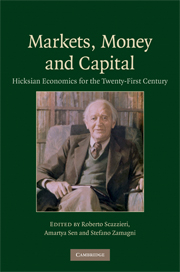Book contents
- Frontmatter
- Contents
- List of figures
- List of tables
- List of contributors
- Preface and acknowledgments
- Between theory and history: on the identity of Hicks's economics
- Part I The Intellectual Heritage of John Hicks
- Part II Markets
- 7 Hicks and the emptiness of general equilibrium theory
- 8 Hicks versus Marx? On the theory of economic history
- 9 Hicks's notion and use of the concepts of fix-price and flex-price
- 10 On the Hicksian definition of income in applied economic analysis
- Part III Money
- Part IV Capital and Dynamics
- References
- Name index
- Subject index
9 - Hicks's notion and use of the concepts of fix-price and flex-price
Published online by Cambridge University Press: 29 June 2009
- Frontmatter
- Contents
- List of figures
- List of tables
- List of contributors
- Preface and acknowledgments
- Between theory and history: on the identity of Hicks's economics
- Part I The Intellectual Heritage of John Hicks
- Part II Markets
- 7 Hicks and the emptiness of general equilibrium theory
- 8 Hicks versus Marx? On the theory of economic history
- 9 Hicks's notion and use of the concepts of fix-price and flex-price
- 10 On the Hicksian definition of income in applied economic analysis
- Part III Money
- Part IV Capital and Dynamics
- References
- Name index
- Subject index
Summary
The coexistence of fix-price and flex-price markets
It is generally accepted that John Hicks attached great importance to the distinction between fix-price markets and flex-price markets. He was by no means the first to notice the existence of these two types of markets, but he was more insistent than most economists in stressing the frequent coexistence of both markets and in trying to model it. More than that, he maintained that flex-price markets needed fix-price ones to survive in the long run. While leaving the theoretical aspects of this issue to people more conversant than I am with theoretical economics, I intend in this chapter to go over Hicks's own use of this notion in the space he dedicated, in his published work, to the analysis of real-life economies, and of economic history.
Fix-price, flex-price, and sticky wages
Hicks noticed the coexistence of the two types of markets in the first important work he produced, his 1932 book The Theory of Wages. Labor markets – he notes there – did not behave in many cases like Marshallian markets. Money wages were sticky, relativities mattered, and – at least in a highly unionized labor market such as the British one, where the union movement was fragmented, by historical reasons, according to the many trades coexisting under the same factory roof and thus given to frequent demarcation disputes – wage-fixing was based mainly on the perception of the need by each trade to maintain a fixed place between adjoining trades.
- Type
- Chapter
- Information
- Markets, Money and CapitalHicksian Economics for the Twenty First Century, pp. 157 - 163Publisher: Cambridge University PressPrint publication year: 2009
- 1
- Cited by



